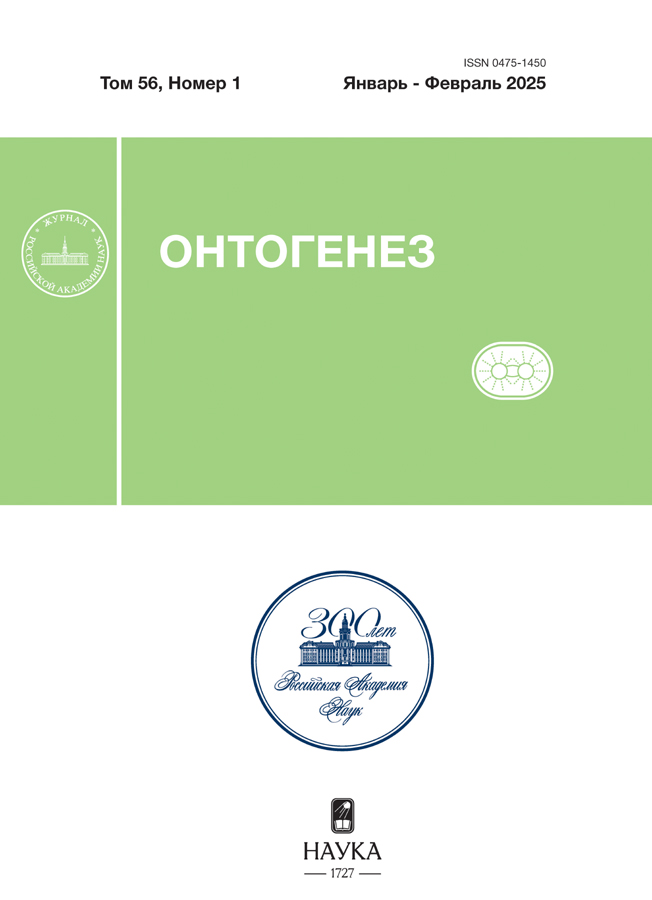Paraphysis and epiphysis primordia of the gecko Correlophus ciliatus at different stages of embryonic development
- Autores: Vingert D.P.1, Gonobobleva E.L.1
-
Afiliações:
- St. Petersburg State University
- Edição: Volume 56, Nº 1 (2025)
- Páginas: 36-41
- Seção: Short communications
- URL: https://rjonco.com/0475-1450/article/view/685005
- DOI: https://doi.org/10.31857/S0475145025010045
- EDN: https://elibrary.ru/KVDTRN
- ID: 685005
Citar
Texto integral
Resumo
The pineal complex and associated brain structures make up the epithalamus. In embryonic development, they form as an evaginations of the diencephalon roof. The structures of the epithalamus are of great interest among scientists due to their involvement in vital physiological functions of mammalian and other vertebrates. Of particular interest are animals in which the pineal complex has a photoreceptor function and includes a parapineal organ (parietal eye). It is described in lampreys, some teleosts, anurans and reptiles in which it is particularly complex. For the first time, we described the early stages of the development of the paraphysis and epiphysis in a representative of the family Diplodactylidae, the gecko Correlophus ciliatus. These primordia are evaginations of the roof of diencephalon, localized on its anterior and posterior borders. At the same time with epithalamic structures in this area of the brain, a network of blood vessels develops. The formation of a blood sinus in the parietal region of the embryo occurs by the 33rd stage of development, before the appearance of the skull. An analysis of the literature showed that the features of the development of the primordia of epithalamic structures in C. ciliatus are similar to the development of these structures in turtles, in which, like in gecko, the pineal complex does not have a parapineal organ.
Palavras-chave
Texto integral
Sobre autores
D. Vingert
St. Petersburg State University
Autor responsável pela correspondência
Email: vingert.31@mail.ru
Department of Embryology
Rússia, Universitetskaya nab. 7/9, St. Petersburg, 199034E. Gonobobleva
St. Petersburg State University
Email: gonobol@mail.ru
Department of Embryology
Rússia, Universitetskaya nab. 7/9, St. Petersburg, 199034Bibliografia
- Бочаров Ю.С. Эволюционная эмбриология позвоночных. М.: Изд-во Моск. ун-та. 1988. 232 с.
- Новиков М.М. Исследования о теменном глазе ящериц // Уч. зап. Имп. Моск. ун-та. 1910. Вып. XXVII. 110 с.
- Aurboonyawat T., Suthipongchai S., Pereira V. et al. Patterns of cranial venous system from the comparative anatomy in vertebrates. Part I, introduction and the dorsal venous system // Interv Neuroradiol. 2007. V. 13. № 4. P. 335–440.
- Bergquist H. On the development of diencephalic nuclei and certain mesencephalic relations in Lepidochelys olivacea and other reptiles // Acta Zool. 1953. V. № 34 1–2, P. 155–190.
- Dufaure J. P., Hubert J. Table de développement du lézard vivipare: Lacerta (Zootoca) vivipara Jacquin // Arch. Anat. Microsc. Morphol. Exp. 1961. V. 50. Р. 309–328.
- Gundy C.G., Wurst G.Z. Parietal eye-pineal morphology in lizards and its physiological implications // Anat. Rec. 1976. V. 185. № 4. P. 419–432.
- Moyer R.W. Comparative morphological and biochemical study of the pineal complex in geckos. Degree of Doctor of Philosophy. Adelaide, South Australia: University of Adelaide. 1998. P. 298.
- Melchers, F. Uber rudimentiire Hirnanhangsgebilde beim Gecko (Epi-, Para- und Hypophyse) // Z. wiss, Zool. 1899. V. 67. P. 139–166.
- Nowikoff M. Udtersuchungen iiber den Bau, die Entwicklung und die Bedeutung des Parietalauges von Sauriern // Z. Wiss. Zool. 1910. V. 96. P. 118–207.
- Quay W.B. The parietal eye-pineal complex // Biology of the Reptilia, Academic Press. 1979. V. 9. P. 245–406.
- Rivas-Manzano P., Torres-Ramírez N., Parra-Gámez L. et al. Histological reinterpretation of paraphysis cerebri in Ambystoma mexicanum // Acta Histochem. 2022. V. 124. № 6. Р. 151915.
- Sapède D., Cau E. The pineal gland from development to function // Curr. Top. Dev. Biol. 2013. V. 106. P. 171–215.
- Stemmler, J. Die Entwicklung der Anhänge am Zwischenhirndach beim Gecko (Gehyra oceanica und Hemidactylus mabouia), Ein Beitrag zur Kenntnis der Epiphysis, des Parietalorgans und der Paraphyse. Leipziger Dissertation, Limburg. 1900. P. 42.
- Studnicka F.K. Die Parietal organe // Lehrbuch der vergleichenden mikroskopischen anatomie der wirbeltiere. 1905. V. 5. P. 167–209.
- Tosini G. The pineal complex of reptiles: Physiological and behavioral roles // Ethol. Ecol. Evol. 1997. V. 9. P. 313–333.
- Warren J. The development of the paraphysis and pineal region in reptilia // Am. Jour of Anat. 1911. V. 11. P. 313–392.
Arquivos suplementares












